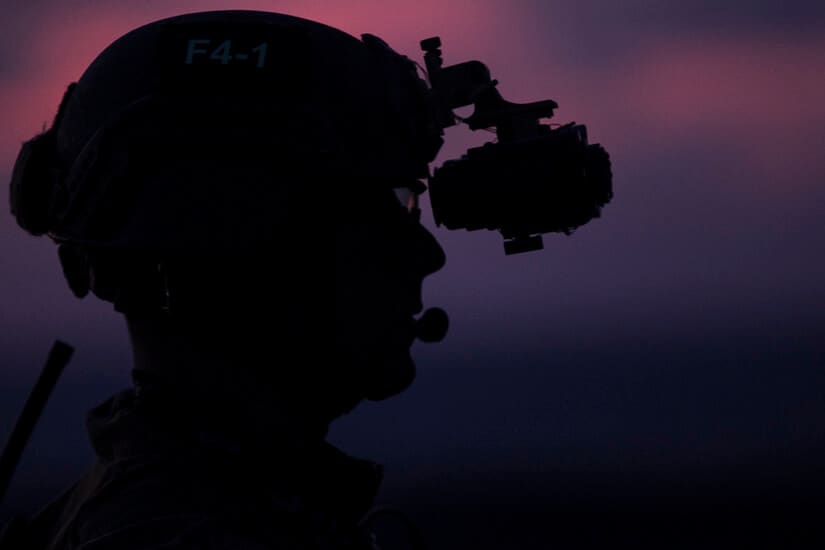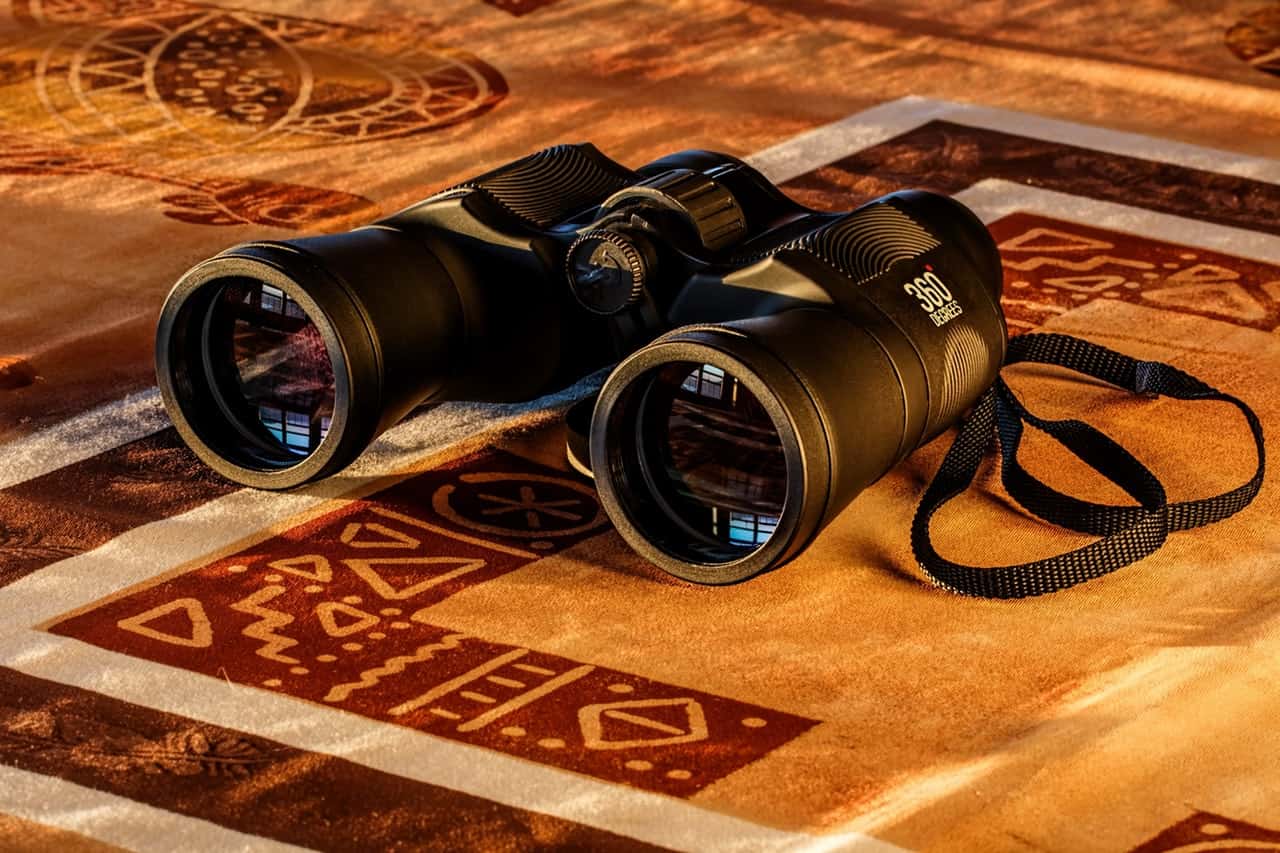There is often confusion between thermal imaging devices and night vision devices, despite both being instrumental in allowing us to see what is not visible to the naked eye. However, there are significant differences between these two technologies. To address this common misconception, I have compiled a list of the top 9 thermal imaging binoculars and bi-oculars for hunting, providing answers to your queries regarding these devices.
Firstly, let me clarify the concept of thermal imaging:
The sun emits radiation, and objects, plants, and animals absorb and reflect a portion of this radiation. Our eyes can only perceive the reflected light, which means that without sunlight, we are unable to see anything. The range of light that falls within our visible perception is referred to as the visible spectrum, which is commonly remembered through the acronym VIBGYOR.
However, beyond the visible spectrum lies infrared radiation, which is invisible to us. To detect and visualize this infrared radiation, specialized sensors are required. This is where thermal imaging and night vision optics come into play. Night vision optics amplify the minimal available light to provide a clearer image, while thermal imaging optics capture the infrared heat emitted by objects.
With thermal imaging optics, you can observe objects in the absence of visible light, enabling you to identify your target or desired object. Initially developed for military use, thermal optics have gained popularity in the hunting community. As a result, there is now a diverse range of thermal optics available specifically designed for hunting purposes.
To assist you further, I have curated a collection of the nine best thermal imaging binoculars and bi-oculars. Together, let us delve deeper into the features and capabilities of these devices.
9 Best Thermal Binoculars and Bi-Ocular Reviews
1. FLIR BHS-XR Command 640 x 480 Thermal Bi-ocular
- FLIR Thermal Imaging Camera
- BHS-XR delivers greater range performance with crisp and clear 320 × 240 native resolution
Specs
- Resolution: 640 x 480
- Digital zoom: 2x and 4x
- Frame rate: 30 Hz
- Lens size: 35, 65 and 100 mm
- Misc: SD card for saving images/videos, aux video jack
As one of the pioneers in thermal imaging domain, FLIR holds a history of more than 50 years, which ensures that it is the master when it comes to thermal imaging binoculars.
This FLIR command Bi-ocular (see price) is specially designed for enhancing the fun of night hunting. If you are passionate about hunting in the dark, FLIR is the go-to brand.
Designed with hunters in mind, the FLIR Command bi-ocular series excels with its impressive 640 x 480 thermal resolution. When it comes to thermal binoculars, resolution is a critical feature that should never be compromised.
The FLIR Command bi-ocular offers a standard resolution of 320 x 240, but it can be extended up to an impressive 640 x 480 by utilizing the auxiliary video jack, which is included with this bi-ocular model.
Additionally, the bi-ocular is equipped with a micro SD card, allowing you to effortlessly transfer captured images and videos to your phone or computer for further analysis or sharing.
For enhanced versatility, this bi-ocular is compatible with three interchangeable lenses: 35mm, 65mm, and 100mm. You have the option to select the lens that best suits your needs or even acquire all three together for a comprehensive viewing experience.
Featuring a robust and waterproof construction, this bi-ocular is built to withstand shocks and ensures its functionality remains intact even in challenging environments. With this reliable bi-ocular, you can confidently navigate and survive in complete darkness, without having to worry about the safety of your optics.
The FLIR Command bi-ocular offers a smooth frame rate of 30 Hz, accompanied by 2x and 4x digital zoom capabilities. This allows you to quickly zoom in and prevent your target from slipping out of sight, ensuring you maintain a clear view and enhance your hunting success.
The 30 Hz frame rate and up to 4x digital zoom are made to meet the needs of military personnel; hunters will get to experience the sophistication of military gadgetry with this bi-ocular. For further details, check here on Amazon FLIR command Bi-ocular.
2. Pulsar Accolade XP50 Thermal Night Vision Binocular
- 2000-yard detection range with 640×480 resolution, 17Am pixel core, High-contrast, color AMOLED display
- Picture in picture digital zoom with a Stream Vision app that connects scope to smart device
Specs
- Thermal resolution: 640 x 480
- Detection range: 1.1 mile
- Detector pitch: 17 microns
- Magnification: 2.5-20x
- Refresh rate: 50 Hz
- Misc: AMOLED display, edge-cutting technology, built-in Wi-Fi, adjustable interpupillary distance
Pulsar never stops bringing innovative features and up gradations to facilitate its users.
For fun and successful night hunts, this Pulsar XP50 binocular has a thermal resolution of 640 x 450 along with a 17 microns detector pitch.
Once you capture an image with this exceptional binocular, its cutting-edge technology takes it a step further by refining the image and providing detailed information about the high and low points of the terrain, enhancing your hunting experience.
The AMOLED display of this binocular ensures that the videos and pictures you view are presented with sharpness, excellent differentiation, and a close-to-reality representation, immersing you in the scene.
With the IPS5 battery, you can rely on this binocular for a consecutive 8 hours of usage. If your mission extends beyond this timeframe, the backup system allows you to extend the battery life, ensuring your binocular remains operational.
Night hunters always seek a higher refresh rate, and this binocular offers an impressive 50 Hz refresh rate, making the hunting process smooth and efficient.
Combining bright imagery, an excellent refresh rate, and a resolution of 640×450, it’s hard to resist capturing the sights you encounter. Fortunately, this binocular comes with a built-in recorder that allows you to document your hunts effortlessly.
Additionally, the presence of Wi-Fi connectivity enables you to live stream your thrilling hunting experiences in the dark, sharing the excitement with others in real-time.
As an added advantage, this binocular features a proprietary stadia metric rangefinder, specifically designed to assist hunters in accurately determining the distance to their target. This feature ensures precision and enables you to experience a thoroughly effective and successful hunt.
The detection range of 1.1 miles and magnification capacity of 2.5-20x, used to be only in the military gadgetry back in the days. But with this pulsar accolade XP50 binocular, you can experience the best thermal hunting binoculars at an affordable price.
Read Also: How do Binoculars Work?
3. ATN BinoX-THD Thermal Smart HD Binocular
Specs
- Thermal resolution: 640 x 480
- Image resolution: 1080p
- Misc: 3D Gyroscope, E-compass, E-zoom, Wi-Fi, Geo-tagging, rangefinder, 3D imagery
When it comes to thermal imaging binoculars and bi-oculars for hunting, ATN stands as an indisputable powerhouse in the industry.
The ATN BinoX binocular represents the pinnacle of cutting-edge technology, making it the ultimate gadget for night hunting enthusiasts. With its state-of-the-art features and capabilities, this binocular ensures that you stay at the forefront of innovation.
With Wi-Fi adaptability, you can easily share the exhilarating moments and thrills with your family back home or post them on your preferred social media platforms, allowing others to join in on the excitement.
No longer will hunters find themselves straying from their intended path. Equipped with a smart and precise E-compass, this binocular assists you in accurately determining your location and guiding you accordingly, ensuring you stay on track.
Thanks to the incorporation of a gyroscope, you can bid farewell to the worry of blurred imagery. This innovative addition ensures stable and steady visuals, providing a clear and focused view of your surroundings.
Once you’ve set your sights on your target, there’s no need to fret about losing it. The E-zoom feature allows you to effortlessly zoom in, with the added convenience of automatic adjustment.
Hunters and navigators alike greatly appreciate the 640 x 480 thermal resolution offered by this binocular, as it guarantees high-quality and bright imagery, allowing for enhanced observation and navigation in challenging environments.
Shooting at precise spots in total darkness can be a daunting task for hunters. However, ATN has provided the perfect solution by incorporating a rangefinder into this BinoX model, ensuring accuracy and improving your chances of hitting your target with precision.
To further elevate the hunting experience, this ATN HD binocular delivers 1080p image quality, perfect for night hunters who require exceptional visual clarity and detail.
Update: The ATN Binox-THD is no longer available at Amazon (as of writing this update), so I will recommend ATN BinoX-HD 4, instead. It’s no doubt a great deal with an affordable price tag.
4. ATN BinoX 4T 640 2.5 – 25×50 Thermal Binocular
Specs
- Resolution: 640 x 480
- Lens size: 50 mm
- Eye relief: 10-30 mm
- Focusing area: 10 ft. to infinity
- Magnification: 2.5-25 x
- Misc: Wi-Fi, E-compass, Built-in illuminator, smooth zoom
ATN is always the first one to bring innovations is thermal imaging binoculars. This ATN BinoX has a built-in illuminator which brightens up the captured imagery and makes it comprehensible.
The ballistic information exchange (BIX) technology is a unique feature ATN has incorporated in this thermal binocular. You can connect with other ATN devices through this technology and enjoy the fun of team hunt.
This binocular has magnification capacity of 2.5-25x, and when it is integrated with the smooth zoom feature, the experience becomes hassle-free.
GPS and E-compass will help you in being on the right path which makes it one of the military-grade binoculars
10-30 mm eye relief distance adds to the perks of this smart BinoX and makes sure that your eyes are comfortable during long hunts.
When it comes to image stabilization, bright imagery, and adjustable colour code, ATN BinoX binocular is the way to go.
The Wi-Fi module lets you share your data with others, and the micro SD card saves your captured imagery for later use.
The internal lithium battery will last for up to 16 hours, ensuring that you never run out of battery during night expeditions.
You can select and see white, black, hot, and cold colour schemes in this BinoX binocular; depending upon the speed and distance of your object.
Due to the vast focusing area, ATN BinoX tops the list of best long-range thermal binoculars.
5. Armasight Command 3 – 12×50 Thermal Imaging Bi-Ocular
Specs
- Thermal resolution: 336 x 256
- Lens size: 50 mm
- Detector pitch: 17 microns
- Digital zoom: 1x, 2x and 4x
- Refresh rate: 60 Hz
- Magnification: 2.4x/3.4x
- Eye relief: 45mm
- Misc: 10mm exit pupil distance, germanium lens, 3 years warranty
Introducing the Armasight Command bi-ocular, specifically designed for night hunting enthusiasts. With its remarkable digital resolution of 336 x 256, this bi-ocular delivers exceptional image quality, perfect for navigating and spotting targets in low-light conditions.
The fusion of this impressive thermal resolution with the 50mm Germanium lens ensures that the images produced are not only bright but also incredibly close to reality. Identifying objects or animals in front of you becomes effortless with the clarity provided by the Command bi-ocular.
For those engaging in long-range hunts, this bi-ocular offers a generous detection range of up to 2 miles, effectively solving the challenge of limited or no light conditions.
The 17-micron detection pitch further enhances image sharpness, providing you with a detailed view of your surroundings.
With a 2.4x/3.4x magnification and a thermal resolution of 336×256, this bi-ocular enables you to conquer even the most challenging terrains, ensuring the success of your hunting mission.
The 60 Hz refresh rate adds to the versatility of this bi-ocular, making it an all-in-one package for hunters, navigators, and adventurers alike.
The smooth zoom feature of the Armasight bi-ocular allows you to effortlessly follow your game without missing a moment, ensuring precise targeting and accurate shooting.
This bi-ocular boasts a beautiful AMOLED SVGA display, where you can save images and videos directly to the internal memory of the device.
The CR123A battery ensures a runtime of up to 4 hours. Additionally, an extra battery is included, providing added convenience and extended usage time in the field.
While the bi-ocular is weather and water-resistant, accidents can still occur. To provide peace of mind, Armasight offers a generous 3-year warranty on the Command bi-ocular, ensuring that your investment is protected.
6. Pulsar Accolade PL77411 Thermal Binoculars
- Sport Type: Fishing
Specs
- Thermal resolution: 384 x 288
- Detection range: 0.8 mile
- Refresh rate: 50 Hz
- Magnification: 3.1-12.4x
- Misc: AMOLED display, adjustable interpupillary distance, built-in rangefinder, and Wi-Fi module
Emerging as the youngest contender in my list of thermal imaging binoculars, the Pulsar Accolade PL77411 is already proving itself as a strong competitor among industry veterans.
With its impressive 384×288 thermal resolution, this binocular excels at extracting the best possible results from the available infrared light. Additionally, you have the freedom to choose from white, black, cold, and hot color schemes, allowing for customization according to your preference.
Hunters often face challenges when trying to obtain a clear view of their focused area, hindered by shrubs, fog, or dust particles. However, the AMOLED display of the Accolade PL77411 effectively clears out these impurities, providing hunters with bright and vivid imagery, enhancing their visual experience.
For those engaging in team hunts, the built-in live stream feature proves highly convenient, enabling hunters to connect and share recorded data, promoting collaboration and enhancing the overall hunting experience.
The integrated rangefinder significantly enhances the chances of hunting success, enabling precise distance measurement to targets. Furthermore, the 3.1-1.24x magnification allows hunters to closely monitor the movement of their game, ensuring nothing goes unnoticed.
Night hunters understand the importance of a vast detection range, and the Accolade PL77411 delivers on this aspect, covering an impressive 1475 yards in one glance, equivalent to 0.8 miles. This extensive range provides hunters with a comprehensive view, improving their chances of spotting targets in the darkness.
In summary, the Pulsar Accolade PL77411 showcases its prowess as a formidable thermal imaging binocular, rivaling more established contenders in the industry. Its exceptional features and performance make it a promising choice for hunters seeking reliable and high-quality optics.
A frame rate of 50 Hz makes this binocular crisp, robust, and compatible with wild environments.
Default battery timing of this binocular is seven hours, which can be further extended by using the 20 hours battery back-up system of this Accolade binocular.
This is a palm-sized thermal binocular explicitly made to survive the rough-tough environments.
7. Armasight Command 640 HD 3 – 24 x 75mm Thermal Imaging Bi-Ocular
Specs
- Thermal resolution: 640 x 512
- Refresh rate: 30 Hz
- Detector pitch: 17 microns
- Lens size: 75mm
- Magnification: 3x to 24x
Armasight is always a step ahead of its competitors, and this bi-ocular with 640 x 512 resolution is the living proof of Armasight’s innovations.
This bi-ocular has 17 microns detector pitch, which produces bright and sharp imagery. Because as I already said; the shorter is the difference between two dots of a thermal image, the better are the results.
You can magnify up to 24x with this bi-ocular, get a detailed view of your game, and record it at the same time. These features make this bi-ocular a smart choice for hunters.
30 Hz refresh rate is not much common in this price range, but for Armasight, facilitating the customers is the top priority.
Thermal binoculars often take time when you start them, but the rapid startup of this bi-ocular is one of its kind.
Depending upon the physical terrain and presence/absence of sunlight, you can switch between black, white, and hot colour patterns.
The large lens of 75mm will show you well-differentiated imagery; hunters’ eyes get tired while focusing on small objects, but now with this large germanium lens.
Digital zoom of 1x, 2x, 4x, and 8x are also there to enhance the fun of your night hunting ventures.
The smooth user interface is there to assist beginners in getting a grip over this bi-ocular; it will save your time during challenging hunts.
The outer body of this bi-ocular is made up of machined-aluminium, which means it is thoroughly water resistant.
8. N-Vision Optics Atlas Thermal Imaging Binocular
Specs
- Detection range: 1.25 miles
- Resolution: 640 x 480
- Detector pitch: 12 microns
- Refresh rate: 60 Hz
- Lens size: 50 mm
- Misc: Edge detection technology, USB port, SD card
The detection range of 1.25 miles makes this bi-ocular the best fit for hunters, spies, and travelers. This N-vision Atlas bi-ocular is specially designed for night hunters who do not dread the challenges coming their way.
The Atlas offers a 60 Hz refresh rate to ensure that you get a quick glance of your moving target because in the wild environment, nobody has time to wait while the bi-ocular clicks an image.
This bi-ocular brings you an amazing resolution of 640 x 480 so that you never have any hindrance in your hunting errand.
There are two available options for digital zooming, 2x and 4x; this selection depends upon the distance between you and your target.
Fully covered with rubber means this bi-ocular will never give in to rough-tough surroundings, which is unavoidable for hunters.
Edge detection is one unique feature that this Atlas bi-ocular possesses. When you are out in the dark, you cannot comprehend the depth of the terrain you are walking on. This Atlas bi-ocular does that for you and lets you enjoy hunting without any mishap.
The 50mm large lens enables you to see a clear picture which the 12 microns detector pitch creates (detector pitch is the distance between two points which a thermal bi-ocular displays; the smaller, the better).
Sharing the captured images has become very convenient since this bi-ocular has a USB port. Data is saved in the bi-ocular’s internal memory and then transferred through the USB port without any hassle.
9. Yukon – NV 1×24 Goggles
- Water and fog resistant
- Built-in PULSE system IR
Specs
- Detection range: up to 100 yards
- Misc: flip-up lens covers, built-in IR illuminator, ergonomic, robust
These NV goggles are the latest addition in the product range of Yukon optics and are not much competitive when it comes to detection range.
However, the built-in infrared illuminator of these night goggle binoculars allows you to see explicit imagery up to 100 yards. For short-range hunts, this detection range is excellent.
The CR123 battery will last for 1-3 hours; if you wish to use it for a longer duration, the IR illuminator must be turned off.
The fully rubberized outer body makes these night goggle binoculars shock resistant and compatible for all terrains.
The flip-up lens covers serve to protect the delicate lenses from rugged environments. If you wish to use these binoculars in daylight, you can close the lens covers and see through the small holes present in them.
These binoculars are as lightweight as a pair of goggles, and the attached strap will keep them securely in place, eliminating the need for frequent readjustments.
The perk of quickly focusing on a moving object has become very convenient with this NV goggle’s central focusing knob.
Multi-coated lenses of these NV 1×24 goggles brings out very bright and sharp imagery; the illuminator further enhances this sharpness.
Yukon offers a limited lifetime warranty on this binocular; freeing you from the worries of the damages which wild environment causes.
How to choose thermal imaging binoculars?
As I said earlier, thermal imaging optics are relatively new in the market; people don’t know much about their specs. Now that you are looking for best thermal binoculars/bi-oculars for hunting, here’re the essential features your thermal optics must have:
Thermal Resolution
Cameras which click bright pictures always have the edge over competitors; same goes for the thermal imaging binos. If they offer better image differentiation and the imagery is bright, you should prefer them.
Pixel size
Pictures are made up of small bits, called pixels. If an image has many pixels, its quality would be better, and you could zoom in to find out more detail. The binoculars which offer more pixels per view are great for hunters (and of course all other activities too).
Frame rate
When we press the button of our camera, and it clicks an image, that’s called frame/refresh rate. It’s slightly different in thermal binos. Let’s say you are running behind an animal, the sensors of your thermal imaging binos will turn the infrared radiation into a picture and then show it to you; if this process takes time, you’ll miss your target. To avoid this, you should opt for binos which offer high frame rate.
Detection range
All that amazing frame rate and a large number of pixels go in vain if you cannot cover a significant distance. Before getting a pair of thermal binoculars, know the detection range they offer (remember it’s different from the regular binoculars). For hunting, a detection range of more than 1 mile would work fine.
Price range
And last comes the price; shortlist the pairs which have your desired features and compare their price range. Do not miss an amazing pair because it’s costly, if you do so, you’ll miss out the real fun of hunting in zero to minimal light.
Tips for thermal imaging binoculars and bi-oculars
As we know, thermal devices are complicated and fragile; if you mishandle them, you are going to regret big time. To avoid any troubles related to your thermal device, follow these tips:
No, you can’t do it yourself
We all are very impressed with those DIY cleaning and repairing videos which YouTube keep recommending us. But when it comes to sensitive gadgetry, STAY AWAY.
Yes, do not think you are a certified technician who can open up those delicate parts, clean them, and place them back just because you have watched a video.
Lenses, eyepieces, illuminator, and microphones, in fact, all parts of thermal imaging optics are sensitive, which should be handled with care. So if you have plans to repair your thermal device at home, forget them.
Protect them
Although most of these optics are shock and weather-resistant, taking care of them is mandatory. Protect them from colliding against hard surfaces, falling in the water and strong in damp or dusty places. Just remember that you’ve spent a lot on this gadget, it will help you in being extremely careful with it.
Frequently Asked Questions
Q. What is the difference between binocular and bi-ocular?
In a binocular, there are two lenses which receive sunlight. When you need to see something up close, you pick the binocular and place it in front of your both eyes. Which means a binocular has two lenses and two eyepieces. The lenses collect brightness, and the eyepieces are those holes where you place your eyes.
But in a bi-ocular, there is only one lens. There is a place for both eyes, but the source which collects light i.e., the lens, is only one.
Hunters prefer bi-oculars over binoculars because these are pretty handy and easy to carry. But, for more secret missions, and exotic hunts, binoculars have the edge over bi-ocular due to the brighter imagery they provide.
Q. Thermal imaging basics (what is thermal imaging)
Sun emits two types of light, infrared and visible. The visible light comes to us in the form of seven colours i.e., the visible spectrum because the objects reflect back these seven colours i.e., VIBGYOR. But we cannot see the infrared light as the objects do not reflect it back.
But, the thermal imaging optics record that invisible light and make it visible to our eyes. Let’s say an animal is moving in the dark; the thermal imaging optics record the heat which the animal’s movement produces and show it to us as a thermographic image. The thermal image we get to see is of various colours mostly red, yellow, black, and white, depending upon the intensity of heat an object emits.
Q. Thermal imaging for hunting – purpose and best practices
Hunters are probably the most challenge-loving people around us. They do not dread the fast moving, and powerful animals and go out to hunt them down. But the biggest hurdle which might put them in danger is the darkness. When it is night time, and someone is wandering around in a jungle, the only way for him to see the surroundings is thermal imaging.
The thermal optics records heat that different objects emit, and when the hunter sees the recorded image, he can find out where his target is and what path should he follow. Most of these thermal optics offer Wi-Fi adaptability so that if you are with a group of hunters, you stay connected with them.
Q. Why are thermal imaging devices so expensive?
There are two reasons behind the steep pricing of thermal imaging optics:
The materials
Most thermal imaging lenses are made up of germanium, a rare and costly metal. Generally, 1kg germanium costs 1500$ to the optics company, and when refining and crafting methods which turn germanium into a lens are combined, the price further rises.
The technology
The regular binoculars and monoculars are common now, one can easily get them from numerous brands. But thermal imaging is a very advanced technology which requires specialized techniques for turning the invisible light to visible one.
The microbolometers, internal memory, gyroscopes, illuminators, and various sophisticated techniques are hard to find, and when you do, they leave a large hole in your pocket.
Q. Can thermal imaging see through walls?
No, they cannot. Let’s say you focus on a house with your thermal binocular, the image it generates will be of the outer wall itself, and not of the things inside. All objects generate heat i.e., trees, walls, water, grass, sand, etc.; we can decipher the type of object in complete darkness with a thermal binocular, but we cannot see beyond those objects.
Same goes for the hurdles present between a hunter and his prey; if there is a tree between the two, the hunter will only see the tree’s infrared radiation.
Q. How thermal imaging works?
Every object, living being, and commodity present on this earth radiates some amount of heat, but we cannot see it with our bare eyes. If we wish to see the objects in darkness, we must record the amount and pattern of heat they radiate.
The thermal imaging optics do that errand for us and bring out a comprehensible image of heat an object emits. For example, if you’ve strayed from your path in a jungle and have no source of light, but you have a thermal imaging device, you can come out safely.
Law enforcement agencies use thermographic images to catch the out of sight suspects and identifying the type of crop being cultivated (as all crops have distinct heat emitting range).
Q. How to read thermal imaging?
When the thermal imaging device curates an image for you, the next step is to decipher what is in front of you. As thermal imaging works when there is heat, the colours which these thermograms show depend upon the amount of heat any object emit; moving objects radiate more heat than the calm ones.
Thermal images used to be in two shades at the beginning i.e., black and white. The white areas represent objects which emit the higher amount of heat, while the black areas show the calmer objects. For example, when you are hunting, the trees present in your way will appear as black, and the animals, birds and moving water will appear as white.
Now, most thermal imaging devices use colour schemes to show heat patterns. Four primary colours used in these thermograms are red, orange, yellow, and purple.
Red colour means the highest heat; if an animal is running, it will emit red light. Then comes orange, which is slightly lesser in the heat than red, such as windy leaves.
Water being a cold surface appears as a purple, and if it’s moving, it will be yellow.
Note: this description of colours is for the hunting environment only if your physical surroundings are different, you will have to determine the types of objects accordingly.
Q. What is thermal imaging used for?
Thermal optics became popular after Boston marathon bombings. In 2013, the police caught a Boston bombings perpetrator hiding in a boat with the help of thermal imaging scope mounted on a surveillance helicopter.
Since then, all optics companies are working to develop state-of-the-art thermal optics, and people are incorporating their usage in all fields. Here are some top areas where we can use thermal imaging optics:
- Firefighters use this to detect the intensity of the fire
- For checking the water and gas leakages in the buildings (as they catch the difference in heat)
- Surveillance of jails when it’s dark
- Hunting wild animals
- Spying
- Border security
- Detecting indoor marijuana cultivations
Q. What blocks thermal imaging?
Although it is almost impossible to dodge the sharp sensors of thermal optics, there are still a few ways to decrease their detection capacity.
Firstly, glass doesn’t reflect the light back, it absorbs it. If one wishes to see what’s behind a glass window with thermal imaging binocular, it’s complicated.
Hard surfaces like trees, walls, rocks, and thick bushes all block the thermal imaging, and if a person or game is hiding behind these objects, you cannot detect them.
Bare skin radiates more infrared light as compared to the one covered with cloths. Full body woollen suits, blankets, and shawls, all blocks the thermal imaging; but they start becoming weak once their temperature matches with the body’s temperature.
Final words
These 9 best thermal binoculars and bi-oculars for hunting which I have reviewed are state-of-the-art devices. If you have plans to enjoy night hunts, thermal imaging optics should be on the top of your wish list.
So, now that you have come this far with me, you must know that detection range, detector pitch, and refresh rate are three essential features we must remember while picking up a thermal imaging device.
Having said that, here are my 3 most favourite devices from the above list:
Pulsar XP50 binocular is for those who do have a deep pocket and want to enjoy the thrill of night hunting. This binocular is a bit expensive, however, it’s extremely robust and compatible with harsh environments.
Armasight Command 3-12×50 Thermal Imaging Bi-Ocular is a multipurpose device with 3 years warranty, large lens, eye-relief distance and incredible thermal resolution of 336×256, and its 60 Hz refresh rate works as a cherry on top.
If your budget is limited and there is not an exotic hunting expedition coming your way, then you should go for Yukon 1×24 goggles, which has all perks of thermal imaging binoculars and will not cost you an arm and a leg.
Thermal imaging devices are the latest “in” thing; if you love adventures, these devices are perfect for you.
So, I tried my best to answer all probes related to this newest technique, and I am sure your confusions are now gone. Greetings!
image courtesy: defense.gov

An optics enthusiast – I love bird watching as well as wildlife. Originally from South Africa, I moved to the UK at a young age. I love reviewing the latest binoculars as well as traveling. I work as a comms consultant during the day. My plan is to travel across the world so building up to that goal.
Last update on 2025-01-21 at 12:25 / Affiliate links / Images from Amazon Product Advertising API










